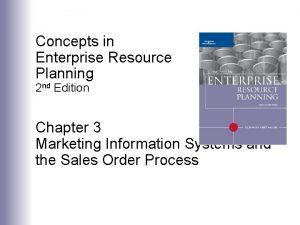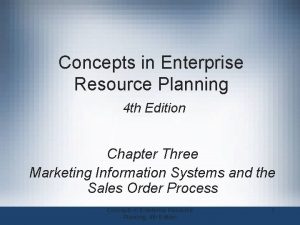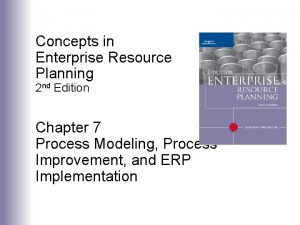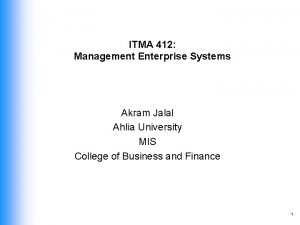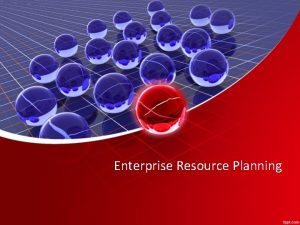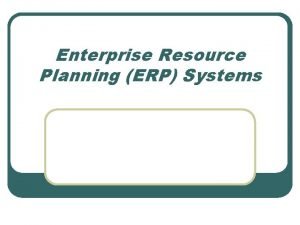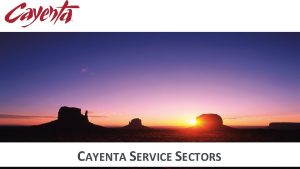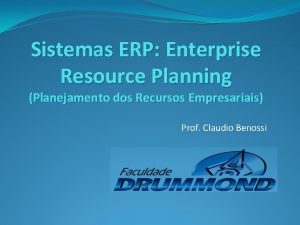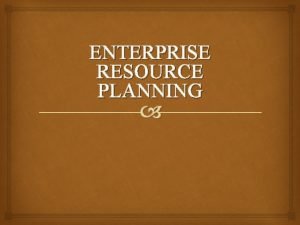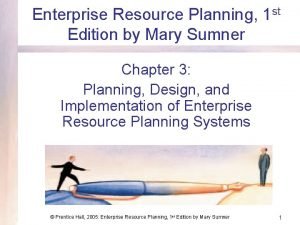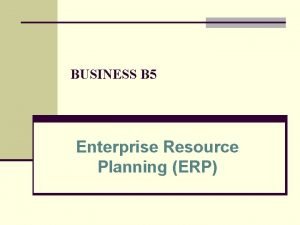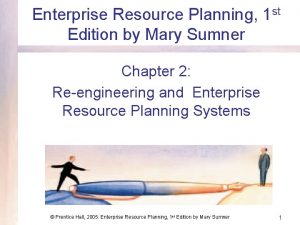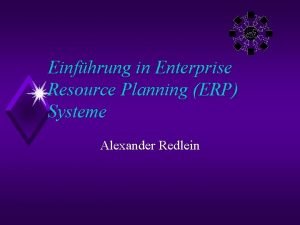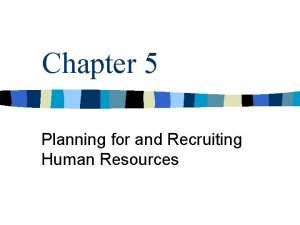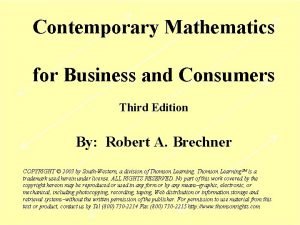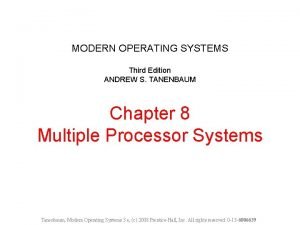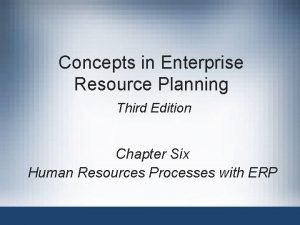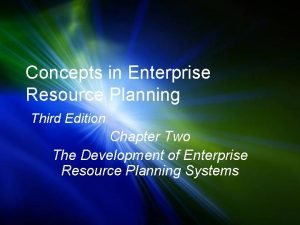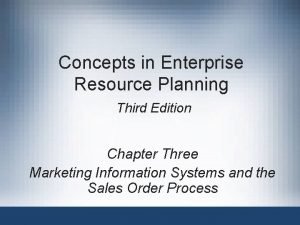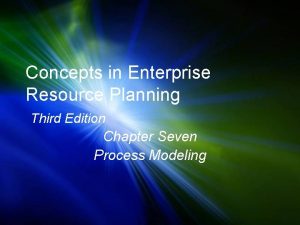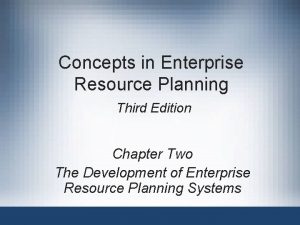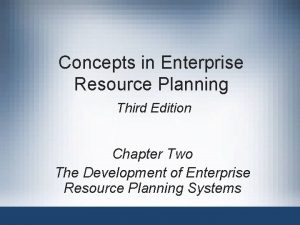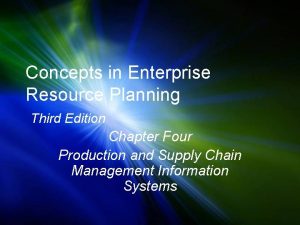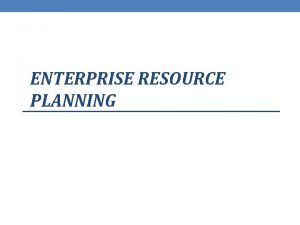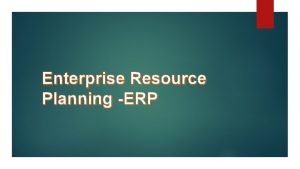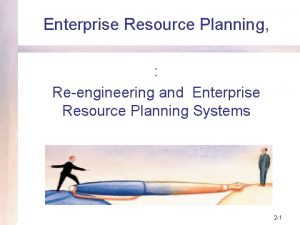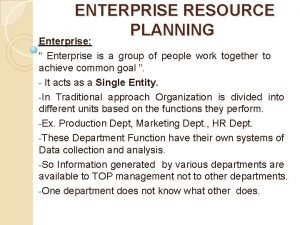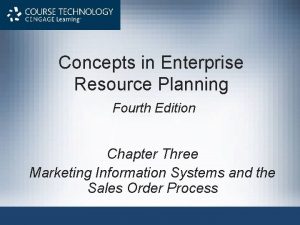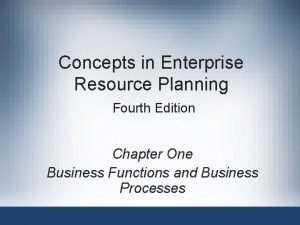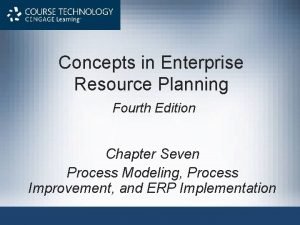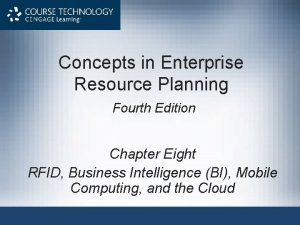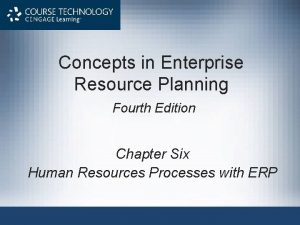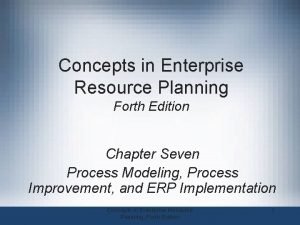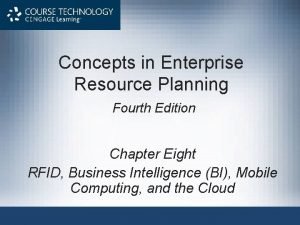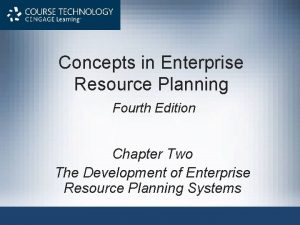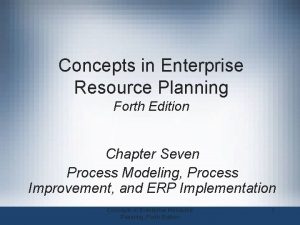Concepts in Enterprise Resource Planning Third Edition Chapter



























- Slides: 27

Concepts in Enterprise Resource Planning Third Edition Chapter One Business Functions and Business Processes

Functional Area Information Systems • Potential inputs and outputs for each functional area described next • Note the kinds of data needed by each area and how people use the data • Information systems maintain relationships between all functional areas and processes Concepts in Enterprise Resource Planning, Third Edition 2

Marketing and Sales • Needs information from all other functional areas • Customers communicate orders to M/S in person or by telephone, e-mail, fax, the Web, etc. • M/S has a role in determining product prices – Pricing might be determined based on a product’s unit cost, plus some percentage markup – Requires information from Accounting and Finance, and Supply Chain Management data Concepts in Enterprise Resource Planning, Third Edition 3

Marketing and Sales (cont’d. ) Figure 1 -4 The Marketing and Sales functional area exchanges data with customers and with the Human Resources, Accounting and Finance, and Supply Chain Management functional areas Concepts in Enterprise Resource Planning, Third Edition 4

Marketing and Sales (cont’d. ) • M/S needs to interact with Human Resources to exchange information on hiring needs, legal requirements, etc. • Inputs for M/S – – – Customer data Order data Sales trend data Per-unit cost Travel expense company policy Concepts in Enterprise Resource Planning, Third Edition 5

Marketing and Sales (cont’d. ) • Outputs for M/S – Sales strategies – Product pricing – Employment needs Concepts in Enterprise Resource Planning, Third Edition 6

Supply Chain Management • Supply Chain Management develops production plans, orders raw materials from suppliers, receives the raw material into the facility, manufactures products, maintains facilities, and ships products to customers. Concepts in Enterprise Resource Planning, Third Edition 7

Supply Chain Management • Needs information from various functional areas • Production plans based on information about product sales (actual and projected) that comes from Marketing and Sales • With accurate data about required production levels: – Raw material and packaging can be ordered as needed – Inventory levels can be kept low, saving money Concepts in Enterprise Resource Planning, Third Edition 8

Supply Chain Management (cont’d. ) • Supply Chain Management data and records can: – Provide data needed by Accounting and Finance to determine how much of each resource was used – Support the M/S function by providing information about what has been produced and shipped • Supply Chain Management interacts in some ways with Human Resources • passes hiring information to HR, and HR informs SCM of the company’s layoff and recall policy Concepts in Enterprise Resource Planning, Third Edition 9

Supply Chain Management (cont’d. ) Figure 1 -5 The Supply Chain Management functional area exchanges data with suppliers and with the Human Resources, Marketing and Sales, and Accounting and Finance functional areas Concepts in Enterprise Resource Planning, Third Edition 10

Supply Chain Management (cont’d. ) • Inputs for SCM – – Product sales data Production plans Inventory levels Layoff and recall company policy Concepts in Enterprise Resource Planning, Third Edition 11

Supply Chain Management (cont’d. ) • Outputs for SCM – – – Raw material orders Packaging orders Resource expenditure data Production and inventory reports Hiring information Concepts in Enterprise Resource Planning, Third Edition 12

Accounting and Finance • Needs information from all other functional areas • A/F personnel: – Record company’s transactions in the books of account. E. g. they record accounts receivable when sales are made and cash receipts when customers send in payments – Record accounts payable when raw materials are purchased and cash outflows when they pay for materials – Summarize transaction data to prepare reports about company’s financial position and profitability Concepts in Enterprise Resource Planning, Third Edition 13

Accounting and Finance (cont’d. ) • People in other functional areas provide data to A/F – M/S provides sales data – SCM provides production and inventory data – HR provides payroll and benefit expense data • M/S personnel require data from A/F to evaluate customer credit Concepts in Enterprise Resource Planning, Third Edition 14

Accounting and Finance (cont’d. ) • If an order will cause the customer to exceed his or her credit limit, M/S should see that the customer’s accounts receivable balance (the amount owed to the company) is too high and hold new orders until the customer’s balance is lowered. If A/F is slow to record sales, the accounts receivable balances will be inaccurate, and M/S might approve credit for customers who have already exceeded their credit limits and who might never pay off their accounts. Concepts in Enterprise Resource Planning, Third Edition 15

Accounting and Finance (cont’d. ) • If A/F does not record customers’ payments promptly, the company could deny credit to customers who actually owe less than their credit limit, potentially damaging the company’s relationship with those customers Concepts in Enterprise Resource Planning, Third Edition 16

Accounting and Finance (cont’d. ) Figure 1 -6 The Accounting and Finance functional area exchanges data with customers and with the Human Resources, Marketing and Sales, and Supply Chain Management functional areas Concepts in Enterprise Resource Planning, Third Edition 17

Accounting and Finance (cont’d. ) • Inputs for A/F – – – Payments from customers Accounts receivable data Accounts payable data Sales data Production and inventory data Payroll and expense data Concepts in Enterprise Resource Planning, Third Edition 18

Accounting and Finance (cont’d. ) • Outputs for A/F – Payments to suppliers – Financial reports – Customer credit data Concepts in Enterprise Resource Planning, Third Edition 19

Human Resources • HR needs information from the other departments • Tasks related to employee hiring, benefits, training, and government compliance are all responsibilities of HR • HR needs accurate forecasts of personnel needs from all functional units • HR needs to know what skills are needed to perform a particular job and how much the company can afford to pay employees Concepts in Enterprise Resource Planning, Third Edition 20

Human Resources (cont’d. ) Figure 1 -7 The Human Resources functional area exchanges data with the Accounting and Finance, Marketing and Sales, and Supply Chain Management functional areas Concepts in Enterprise Resource Planning, Third Edition 21

Human Resources (cont’d. ) • Observing governmental regulations in recruiting, training, compensating, promoting, and terminating employees • Inputs for HR – Personnel forecasts – Skills data Concepts in Enterprise Resource Planning, Third Edition 22

Human Resources (cont’d. ) • Outputs for HR – – Regulation compliance Employee training and certification Skills database Employee evaluation and compensation Concepts in Enterprise Resource Planning, Third Edition 23

Human Resources (cont’d. ) • Significant amount of data is maintained by and shared among the functional areas • Timeliness and accuracy of these data critical to each area’s success and to company’s ability to make a profit and generate future growth • ERP software allows all functional areas to share a common database – Allows accurate, real-time information to be available Concepts in Enterprise Resource Planning, Third Edition 24

Summary • Basic functional areas: Marketing and Sales, Supply Chain Management, Accounting and Finance, and Human Resources • Marketing and Sales: Sets product prices, promotes products through advertising and marketing, takes customer orders, supports customers, and creates sales forecasts • Supply Chain Management: Develops production plans, orders raw materials from suppliers, receives raw material, manufactures products, maintains facilities, and ships products to customers Concepts in Enterprise Resource Planning, Third Edition 25

Summary (cont’d. ) • Accounting and Finance: Financial accounting to provide summaries of operational data in managerial reports, controlling accounts, planning and budgeting, and cash-flow management • Human Resources: Recruits, hires, trains, and compensates employees, ensures compliance with government regulations, and oversees the evaluation of employees • Information systems capture, process, and store data to provide information needed for decision making Concepts in Enterprise Resource Planning, Third Edition 26

Summary (cont’d. ) • Employees working in one functional area need data from employees in other functional areas – Functional area information systems should be integrated, so shared data are accurate and timely • Managers think in terms of business processes that integrate the functional areas – Need to share information between functions and functional areas – ERP software provides this capability by means of a single common database Concepts in Enterprise Resource Planning, Third Edition 27
 Enterprise resourse planning
Enterprise resourse planning Concepts in enterprise resource planning
Concepts in enterprise resource planning Fitter snacker
Fitter snacker Enterprise resource planning example
Enterprise resource planning example Erp meaning
Erp meaning Enterprise resourse planning systems
Enterprise resourse planning systems Cayenta general ledger
Cayenta general ledger Sistema erp adalah
Sistema erp adalah Konsep erp
Konsep erp Enterprise resource planning mary sumner
Enterprise resource planning mary sumner Core and extended erp components
Core and extended erp components Enterprise resource planning ppt
Enterprise resource planning ppt Enterprise resource planning mary sumner
Enterprise resource planning mary sumner Sap lieferplan kopierer sd
Sap lieferplan kopierer sd Odontoclasia meaning
Odontoclasia meaning Mount classification of dental caries
Mount classification of dental caries Chapter 5 human resource planning and recruitment
Chapter 5 human resource planning and recruitment Principles of economics third edition pdf
Principles of economics third edition pdf Organic chemistry (3rd) edition chapter 1 problem 20s
Organic chemistry (3rd) edition chapter 1 problem 20s Organic chemistry third edition david klein
Organic chemistry third edition david klein Business mathematics third edition
Business mathematics third edition Modern operating systems tanenbaum
Modern operating systems tanenbaum Fundamentals of corporate finance third canadian edition
Fundamentals of corporate finance third canadian edition Fundamentals of corporate finance, third canadian edition
Fundamentals of corporate finance, third canadian edition Lifespan development third edition
Lifespan development third edition Lifespan development third edition
Lifespan development third edition Essential cell biology chapter 1
Essential cell biology chapter 1 Graphical display
Graphical display
